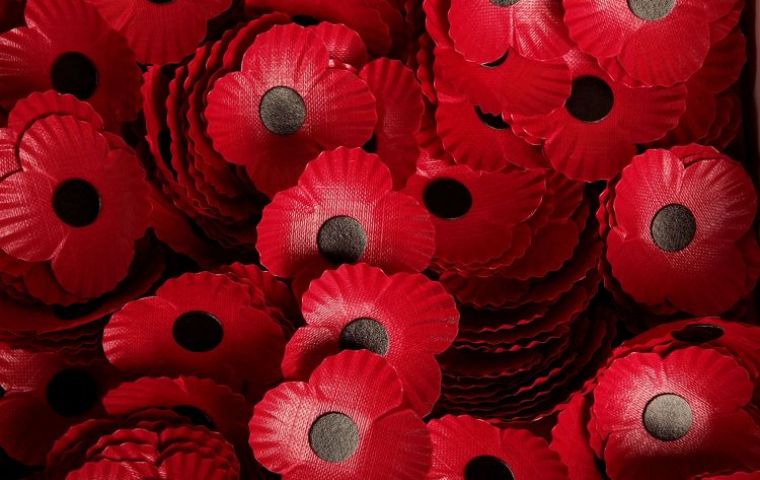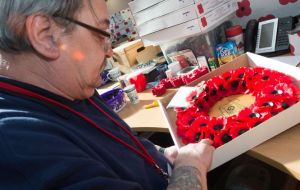MercoPress. South Atlantic News Agency
The difference between the Scottish and English poppies: botanically incorrect
 Hundreds of poppies made at Lady Haig's Poppy Factory in Edinburgh (Picture: Poppyscotland)
Hundreds of poppies made at Lady Haig's Poppy Factory in Edinburgh (Picture: Poppyscotland) Did you know that not all Remembrance poppies look the same? Although the poppy is a universal symbol of Remembrance, the way each country makes them is very different.
It is not a Scottish poppy v English poppy thing – they are both sold to raise money to support the Armed Forces and veterans’ community but there is a noticeable difference between what they look like and where the money raised by them goes.
When the Edinburgh-based factory that makes the Scottish poppy was set up in 1926, the look of the poppy was redesigned for sale north of the border.
The two-petal poppy, still sold in England, Wales and Northern Ireland to this day, has a leaf attached, something charity Poppyscotland says is botanically incorrect.
The distinctive Scottish poppy - a four-petal poppy made from vibrant red, crimped paper - was designed by Lady Haig. She was the wife of Earl Haig, Commander in Chief of the British Army from 1915 until the end of the First World War.
Earl Haig set up the British Legion in May 1921 to support injured ex-servicemen and their families in the aftermath of the brutal and deadly WWI. The word Royal was added in 1971 to celebrate the charity's 50th anniversary.
American academic Moina Michael and French lecturer Madame Anna Guérin were inspired by the moving poem 'In Flanders Fields by Canadian doctor and soldier Lieutenant Colonel John McCrae to use the poppy as a symbol to represent all who died during the First World War to make sure their sacrifice is never forgotten.
Earl Haig was keen for the poppies made in France to be sold to the people of Britain so that much-needed money could be raised to help First World War veterans. However, the demand for poppies outgrew the ability to supply them so very few poppies made their way to Scotland.
Lady Haig decided in 1926 that if poppies could not be produced by the factory in England, she would set up her own factory in her home country of Scotland. In order to do this, she set up a small factory at the bottom of the Royal Mile in the grounds of Whitefoord House in a shed. Described by Major (Retd) Charlie Pelling, Lady Haig Poppy Factory manager as being:
“Three or four blokes and a pair of scissors and a bit of crepe paper and by the end of the 20s she was employing over 100 men making the Scottish poppy and making other items that could be sold to raise money to help Scottish ex-servicemen and their families who were in distress.”
The design of the Scottish poppy has not veered too far away from Lady Haig's original vision of a four petal, crimped poppy with no leaf.
Veterans, many of whom live with disabilities, are employed by Lady Haig’s Poppy Factory in Edinburgh to hand-assemble more than three million poppies and 10,000 wreaths every year for the Scottish Poppy Appeal.
To mark 100 years since the end of the First World War, the veterans made a special 'Centenary Poppy' with “1918-2018” embossed in gold. This was the first change to the look of the Scottish poppy in decades, albeit for one year only.
Poppyscotland gave the Scottish poppy another new looks this year to mark the centenary of the poppy appeal.
Money raised from the Scottish Poppy Appeal, along with its other fundraising, enables the charity to deliver support to service families, veterans and those currently serving in Scotland. Every penny donated to the Scottish Poppy Appeal is spent in Scotland.
Thousands of volunteers sell the Scottish poppy on high streets, in supermarkets and train stations among other places and people can order a variety of different items like wreaths, ties and dog collars online via the Lady Haig's Poppy Factory website
You can also buy other items from the online Poppyscotland store that use the distinctive Scottish poppy image like pins, clothing, jewellery, spirits and much more.
The Scottish Poppy Appeal raised £2.3 million in 2020, but last year £3.4 million was spent to support the Armed Forces community in six areas: 1, Financial Support; 2, Advice; 3,Employment; 4, Mobility; 5,Housing and 6, Mental Health
The Scottish Poppy Appeal was originally separate from The Royal British Legion’s appeal in England, Wales and Northern Ireland. Poppyscotland is a separate charity within the Royal British Legion group and merged with RBL in June 2011 to share resources and expand the reach of both.





Top Comments
Disclaimer & comment rulesCommenting for this story is now closed.
If you have a Facebook account, become a fan and comment on our Facebook Page!